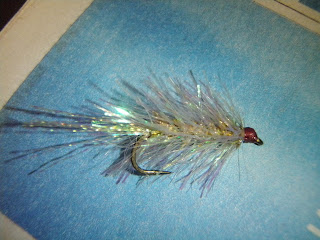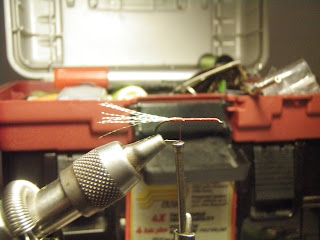Feather Duster nymph
This pattern was a god send once(and ever since) at Peterhope Lake during a huge mayfly hatch (see story here) we happened upon many years ago. Since then it has been a staple in my fly box for BC interior mayflies. I thought since the still water season is just around the corner I'd share this with you now so you can get a few into the boxes in time for the early hatches. Also being weighted it is a good option for early season cutthroat when they get finicky after gorging on fry early morning and turn to nymphs for 'dessert' in the afternoon.
Here is what you will need:
Hook: #10 regular shank
Thread: Black 8/0
Weight: 8-10 turns of .020 lead
Tail/legs/halfback: Mallard Flank
Rib: Fine Gold Wire
Body: Olive, Brown or natural Ostrich
Instructions:
Debarb hook in vice
Add turns of lead just forward of mid shank and anchor/cover with thread
Cover the rest of the hook with thread, and wind back to the rear, and tie in a few fibers of mallard flank for the tail as well as gold wire for the ribbing. The tail should be approximately as long as the flat of the hook shank.
One of the 'things' about this pattern is everything gets tied on before you do any wrapping so it's prudent to make good use of the hook shank to allow for proper body proportions on the finished product.
Now select 3 ostrich herls and tie them in by the tips on top of the shank and leave them extended out the back of the fly (possibly using a keeper to hold them out of the way)
Next, move the thread forward to about the halfway point and tie in the shell back/legs. The tips of the mallard flank will be the legs when swept back, and the butts of the same will be the shell back so choose appropriate size of feather for this application.
Tie them in with the tips extending forward over the hook eye while the butts will be used to create the shell back, bend them upward to facilitate wrapping process again using the hook shank as a gauge for length of the mallard flank tips to extend past the head area. (not including the hook eye)
Now you are set to begin wrapping up the ingredients to complete the fly. There is one key trick to making this 'easy' and that is getting around the shell back of the mallard flank with both the ostrich plumes as well as the wire rib. If you find the shell back portion is in the way (it wasn't 'this time' when I tied it up but it well can be a nuisance while tying) since the thread is at the head section one can hold it out of the way of the rear tying area with a couple of wraps over it while wrapping and then undo them to allow the fibers to pop back up and continue to the head section.
Wrap the herl forward in close touching wraps making sure to create thin abdomen with a gradual taper towards the thorax. The lead placement really helps here and should be thought about when doing the placement. Tie off just back of the hook eye to leave room for a head.
Next COUNTER wrap forward the gold wire to give segmentation, flash as well as strength to the delicate ostrich herls.
Now fold down the shell back and secure and trim. Again make sure to have a decent head area when doing so.
Now divide the 'legs' and sweep half at a time back along the opposite side of the fly to create a good profile and tie each down one at a time.
Whip finish, glue, and there you have it, an awesome olive mayfly pattern that really breathes in the water. I like fishing them up shallow when a migration is on right IN the reeds with a slime line or Ghost tip.
Have fun!!!
Olive Mini Leech
Gold and Silver
Well actually it's Pearl and gold but when I tied it I kept calling it the gold and silver so there it is.
As time goes by I will be putting together a better studio to take fly pics, but for now you guys can put up with my shit in the background and artsy settings like a blue square on the front page of the Province for colour background effect.

As most successful patterns are this one is a mix of a few ideas including pattern as well as materials as in utilizing new takes on fly construction in relation to what trout are 'likely' to see and interperet as food in this case the the accent falls on the UV spectrum.
The original idea came from Todd Oishi when he gave me a pattern that he was having great success with that he called the TNT because it was dy-no-mite and it was. We did really well with it for both cutthroat and coho. His was basically the same pattern but achieved in a different manner and as we'll see one that can be more adaptable depending upon the target species, mood of the tier, or the need for specific apllication. With this recipie literally the sky is the limit because this is just a flashy synthetic version of a woolly bugger. Just another retake on what is probably the best fly ever invented.
Todd's version was after tying on a tail of flashabou, using the UV pearl palmer chennille, lashing it to the hook, doubling the material forming it into a loop and tying the end back to the shank. The resulting loop of palmer chennille was gripped with hackle pliers and spun, making a giant 'super' chennille which was wound forward stroking it back all the while up to and tied of behind a bead with olive thread.
The Crocodile
I came up with this fly at least 5 years ago after somebody schooled me with the spoon of the very same name for the umpteenth time. Proud of how it looked and moved in the water, I fished it hard the first few months after it's conception and had no results. I mean NOTHING. I tried it in sloughs, the ocean, rivers, and even lakes but for the life of me I couldn't get bit on it. After the initial freverent trial period, it just sat in the box next to the other one I tied, possibly both talking about how good they looked vs how well they worked.
Fast forward 3 or 4 years and I found myself hunting for purported 'fresh' coho that were supposedly 'in' at Kanaka Creek. Upon arrival we saw that the tide had really moved in and had started it's way back out. The water was VERY coloured and as such visiblity was a problem. (in my mind anyways) Fish were moving here and there (they turned out to be cutthroat) but only a single fish fell to the flash pattern (to be included in this blog as time goes by) I had opted for even though I had hit the rings of several movers.
Opening the fly box seeking alternatives, I saw the silver/orange flash of the 'Croc, and with a small inward sigh and little hope, I tied it on.
A fished moved and I cast, having just clipped the tippet tag, of course, it landed bad - like 5' away from the rings.
*POW*
A nice cutthroat hit the fly and stayed stuck. "Flukey" I'm thinking, bring that fish to the net, release it. While I'm doing so another fish moves a little upstream of where I'm landing this one. The fish I landed took right off, so since the flow of the tide was slow yet, I presented the fly upstream to the fading rise rings having no idea if I was even in the game and *doink* another cutthroat leapt to life at the end of the line.
I caught 7 more fish there with the same fly and filed it for future reference.
Coho season came along and since the slide in Harrison lake, the lower river itself has become increasingly coloured. On a hunch I started fishing the Crocodile with what can only be described as astounding success. Not only did it simply slay the cutthroat where other patterns failed, it totally annialated the coho as well.
Coho jack fooled by the 'Croc
Couple of coho examples of the Crocodile and it's effectiveness
This fly has caught me more cutthroat than I can count. These days it's first fly on in the morning on coloured water and the last fly tried.
Recipie:
Hook: Mustad Big Game 2XH/STD
Bead: Silver coated brass bead 7/23
Thread: Orange 6/0
Tail: Orange marabou
Body: Orange marabou dubbed onto thread (remainder from tail plume)
Collar/skirt: Large UV polar chenille - 3 turns
Head: Prominent band of orange behind the bead
Materials required
After debarbing the hook, slide on the bead and clamp it securely in the vise, lay a good base of thread to dress on to the hook bend.Tie in marbou tail about the center of the feather with a few wraps and trim the excess. Next pinch off the tips of the tail so it's about the same length as the hook shank. Secure the rest of the marabou and wind back.
Using the remainder of the feather both tips and butts, dub onto thread
And wind forward making a uniform body taking care to anchor the bead somewhat. Next tie in the chenille so that the fibers point toward the rear of the pattern, this helps managing the material for the end product.
3 wraps only taking care to manage the fibres as best you can rearward, and tie off. Trim excess chenille rope with care.
Sweep all the fibers back with your left hand and form an orange collar with thread, glue, whip finish, and glue again.
That's not a type-o lately I have taken to adding glue to the thread before the whip finish as well as gluing afterwards. Unbelievable difference in pattern durability.
Fish this fly in coloured water of all kinds, on the swing, but really excells being stripped both fast and slow. One thing it's prudent to mention is at times this pattern can foul so if it's working and then stops or not working at all, try seeing how tangled up the skirt/tail is before switching it up.
Have fun.





























No comments:
Post a Comment